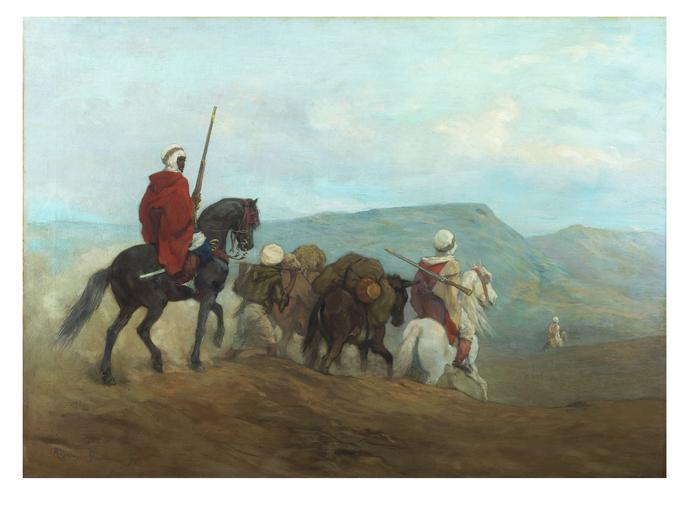MAKE A MEME
View Large Image

| View Original: | Arab Horse Soldiers - Spahis.jpg (2500x1867) | |||
| Download: | Original | Medium | Small | Thumb |
| Courtesy of: | commons.wikimedia.org | More Like This | ||
| Keywords: Arab Horse Soldiers - Spahis.jpg Spahis cavaliers descending a declivity in the desert and a man on foot driving two laden mules The bright light and subject matter is characteristic of the Orientalist movement a 19th-century phenomenon which pervaded French art by combining elements of Romanticism such as the attraction to distant and Middle East settings and Realism in the objective rendering of the figures 1871 painted oil on canvas size cm 76 2 105 Weight 31 5kg with frame size cm 101 135 Institution Victoria and Albert Museum London within the institution Paintings room 81 case WEST WALL exhibition history 19th-century French art is marked by a succession of movements based on a more or less close relationship with nature At the beginning of the century Romantic artists were fascinated by nature they interpreted as a mirror of the mind They investigated human nature and personality the folk culture the national and ethnic origins the medieval era the exotic the remote the mysterious and the occult This movement was heralded in France by such painter as Eugène Delacroix 1798-1863 In its opposition to academic art and its demand for a modern style Realism continued the aims of the Romantics They assumed that reality could be perceived without distortion or idealization and sought after a mean to combine the perception of the individual with objectivity This reaction in French painting against the Grand Manner is well represented by Gustave Courbet 1819-1877 who wrote a 'Manifesto of Realism' entitled Le Réalisme published in Paris in 1855 These ideas were challenged by the group of the Barbizon painters who formed a recognizable school from the early 1830s to the 1870s and developed a free broad and rough technique They were mainly concerned by landscape painting and the rendering of light The works of Narcisse Virgile Diaz de la Peña 1807-1876 Jules Dupré 1811-1889 Théodore Rousseau 1812-1867 Constant Troyon 1810-1865 and Jean-François Millet 1814-1875 anticipate somehow the plein-air landscapes of the Impressionists object history Commissioned by Constantine Alexander Ionides from the artist Titled <u>Spahis</u> it entered Ionides' collection after October 1873 cf letters dated March to October 1873 private collection ; listed in Ionides' inventory of November 1881 as 'Cavaliers Arabes' by Regamey with a valuation of £100; bequeathed by Constantine Alexander Ionides 1900 Historical significance This painting shows three Arab horsemen descending a declivity in the desert Such cavalry were known as spahi and were also found in French colonial regiments They were a common theme in Régamey's oeuvre which principally comprised depictions of horses and horsemen He does not seem to have visited Africa but made many sketches of Arab horsemen probably after other artists' designs His visual memory was said to be considerable and enabled him to recreate details and compositional formulae in his atelier This painting was commissioned by Constantine Alexander Ionides from the artist whom he had probably met through the intermediary of Legros during the winter 1870-71 At that time Régamey was contributing to the Illustrated London News Although the painting is signed and dated 1871 letters from the artist in Paris to Constantine Alexander Ionides dated between March and October 1873 private collection suggest that it was still unfinished in October 1873 Régamey made at least two preparatory studies for this painting a sketch in pastel in the Musée d'Orsay Paris RF29262 dated 14th March 1871 and another in pen and ink Musée du Louvre RF 29273 credit line 'Regamey Guillaume 71' Landscape with bare hills In the foreground are two Arab horsemen with red cloaks and between them a man on foot driving two laden mules The party is descending a declivity towards the spectator's right and is preceded at a distance by another horseman accession number CAI 73 http //collections vam ac uk/item/O81376/oil-painting-arab-horse-soldiers-spahis/ collections vam ac uk PD-old-100 Arabs Guillaume Régamey 19th-century paintings Cavalry of the Islamic World Spahis | ||||